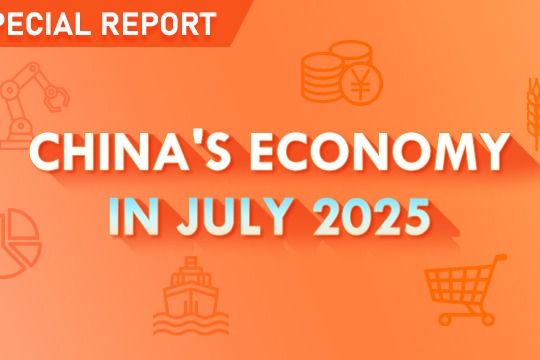Property finishes another tough year, but hope on horizon


The Chinese real estate market experienced a third straight year of downward momentum, with both real estate sales and investment growth rates experiencing double-digit declines. The sector has become the biggest lag on domestic demand. Therefore, the central government rolled out a series of decisive and evolving policies throughout 2024 to stabilize the sector.
The meeting of the Political Bureau of the Communist Party of China Central Committee said in April it would combine the digestion of existing inventory with the optimization of incremental growth in the property sector.
In September, the meeting called for forceful steps to reverse the property market downturn and stabilize the sector, and, later in December, stressed dedicated efforts on both the supply and demand sides to stabilize the housing market.
China's real estate market has shown tentative signs of stabilization and improvement since October, fueled by a notable rebound in residential housing demand. The shift in market dynamics has been evidenced by rising sales of new homes and second-hand homes, stabilization of home and land prices in top-tier cities, and a shortening of the destocking period for commercial housing inventory.
That said, whether the real estate market has sufficient momentum for a sustained recovery remains to be observed. The real estate market still faces challenges such as overall year-on-year declines in housing prices, partially mitigated credit risk of real estate enterprises and regionally strained local government finances.
Looking ahead to 2025, China's real estate market is expected to further stabilize, with the contraction in sales and investment moderating. However, full-fledged market recovery and stabilization will take time, and the extent of the recovery will depend on the strength of policies to stabilize the economy and address housing inventory.
Stabilizing the economy is key to stabilizing the real estate market. In 2025, the implementation of more proactive and effective macroeconomic policies, with more proactive fiscal support for real estate stabilization, will help drive income growth through economic expansion, thereby restoring consumer confidence and purchasing power, and promoting a virtuous cycle between the economy and real estate.
Continued efforts in destocking policies are necessary to achieve a better balance between supply and demand in the real estate market. In 2025, local government special-purpose bonds will be directed toward inventory housing acquisition and idle land reserve purchases, and the central bank's affordable housing refinancing facility and white-list project lending facility will be utilized.
These measures combined will help accelerate the real estate market's approach to supply-demand equilibrium. The commercial housing market is expected to return to a positive growth trajectory in terms of both volume and prices by 2026.
In 2025, further policy support and the release of pent-up housing demand will contribute to a more substantial recovery in new home sales. However, the scale of new housing supply will remain constrained. As a result, the forecast is that the sales area of commercial housing will decline by around 6 percent year-on-year in 2025.
Investment in the real estate sector in 2025 is expected to still lag behind sales, and the challenge of destocking undeveloped land inventories remains significant. New land acquisitions and construction investments are expected to remain at a relatively low level for an extended period.
As a result, real estate investment is expected to decline by around 8.5 percent year-on-year in 2025. However, if the construction of affordable housing and dilapidated urban village redevelopment projects accelerates, it could help narrow the decline in real estate investment.
In the medium to long term, China's housing demand will enter a development stage focused on structural optimization and quality improvement over the next decade. Overall, housing demand is expected to exhibit a slowly declining trend toward stability in the coming decade.
In terms of structural optimization, basic housing demand will see a moderated decline, demand for renovation and reconstruction will remain relatively stable, and upgrade-driven demand will gradually increase.
Continued urbanization and smaller household sizes leading to an increase in the number of urban households, rising household incomes driving gradual increases in average living space per urban household — alongside ongoing urban renewal projects continually stimulating reconstruction demand — will provide medium to long-term support for the real estate market.
Housing demand will continue to grow in areas with net population inflows and strong industrial competitiveness, while the housing markets in areas with net population outflows and weak industrial competitiveness will remain sluggish.
As soon as possible, unnecessary restrictive measures should be lifted to allow commercial housing to return to market-based operations. In the short term, further relaxation of restrictive policies in first-tier cities will help stabilize home prices in major urban areas, setting an example and gradually arresting the decline in sales volume across the market.
Currently, only a few cities like Beijing, Shanghai, and Shenzhen still implement purchase restrictions, and there is a need to further relax these policies. For example, lifting restrictions on purchases in suburban areas and large-unit purchases, reducing the social insurance contribution period for nonlocals, and increasing purchase quotas for families with multiple children are all advisable.
It is necessary to coordinate strict controls over incremental housing supply and the optimization of existing housing stock. Efforts should be increased to support the acquisition of existing commercial housing stock and the idle land reserves of property developers.
It is recommended that a special-purpose bond quota of between 500 billion yuan ($68.5 billion) and 1 trillion yuan be allocated in 2025 to support the acquisition of existing commercial housing for use as affordable rental housing. Future rental incomes can be used as a source of debt repayment. The special-purpose bond quota should be mainly allocated to provinces having relatively high commercial housing inventories.
Additionally, research can be conducted on issuing additional government bonds to establish a real estate stabilization fund at the central government level, with an expected scale of 2-3 trillion yuan. This fund can be specifically used for completing unfinished projects, acquiring existing housing and purchasing idle land reserves. This will demonstrate an unwavering determination and send a strong signal to stabilize the real estate market.
A systematic risk resolution plan for real estate enterprises should be formulated, with differentiated treatment of their credit risks. The effectiveness of financing support policies for real estate enterprises should be enhanced, with classification-based policies for different firms and projects, thus avoiding a one-size-fits-all approach and reducing financing restrictions on nonresidential projects.
Important high-quality enterprises should be identified and treated accordingly. For these enterprises or those facing short-term liquidity risks, nonperforming asset disposals should be supported, and State-owned enterprises should be encouraged to participate in equity acquisitions, debt restructuring and project cooperation to revitalize assets.
For insolvent enterprises, drawing on experiences from the United States and Japan, high-quality assets should be spun off, while a government-led stressed asset management agency should be established to work with market institutions to complete bankruptcy reorganizations.
The writer is chief economist at Yuekai Securities.
The views do not necessarily reflect those of China Daily.




































